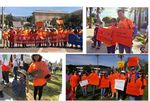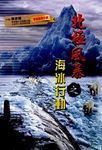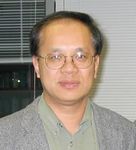Chinese-American Oceanic and Atmospheric Association
←
→
Page content transcription
If your browser does not render page correctly, please read the page content below
Chinese-American Oceanic
Chinese-American Oceanic and
and Atmospheric
Atmospheric Association
Association E-News,
E-News, Issue
Issue 47,
47, May
May 2017
2017
Chinese-American Oceanic and
Atmospheric Association
Mail Box: P. O. Box 1293, Greenbelt, MD 20768, USA
Web Page: http://www.coaaweb.org
Editor: Yingxi Shi
About the COAA
COAA is a member-led, all-inclusive, non-profit, professional association supporting its
members and promoting excellence in oceanic and atmospheric sciences and related
activities. Members have many opportunities to share information, news, studies and
concerns related to the fields of oceanic and atmospheric sciences through board work,
submitting correspondence or articles to the COAA Newsletter, leading workshops and
making presentations at the Annual Meetings, making contributions to the COAA website,
and networking with people in a wide variety of careers (from well-known senior
professionals to young environmental enthusiasts).
Science Program: Yaling Liu (刘亚玲, PNNL)
COAA Board Members for 2017
Coordinator: Nai-yu Wang (王乃瑜, NOAA)
Board of Directors
Office of Internal Affairs
President: Jianhe Qu (曲建和, GMU)
Treasury: JiangTao Xu (徐江涛, NOAA)
President-Advisor: Chungu Lu (陆春谷, NSF) Membership: Wenze Yang (杨文泽, UMD)
President-Elect: Mian Chin (秦勉, NASA) Board Member Assistants
Office of Secretary Chenyang Xu (徐晨阳, GMU)
Hao He (何昊, UMD) Jiexia Wu (吴洁瑕, GMU)
Office of Public Affairs
Newsletter: Yingxi Shi (石颖希, NASA)
Table of Contents
COAA Participated March for Science... 2 Professor Huadong Guo seminar at
COAA hosted 2017 Ping-Pong ESSIC .................................................... 8
Tournament.......................................... 3 2017 Yuxiang Young Scholar Award ...... 9
COAA Spotlight: Dr. William K. M. Lau .. 4 Recent Opportunity Announcements . 10
COAA Spotlight: Dr. Yongkang Xue ...... 6 A Novel By Antony Liu (NASA/GSFC) .. 12
1Chinese-American Oceanic and Atmospheric Association E-News, Issue 47, May 2017
COAA Participated March for Science
April 22nd 2017 Saturday– people around the world gathered in support of science. Here at
Pasadena, COAA SCC members and families marched hand in hand with fellow scientists
and cared citizens to “defend an approach, a mode of inquiry based in data, evidence and
reason, that has illuminated the natural world and transferred society” as stated by
Professor Thomas F. Rosenbaum, the president of Caltech.
Initiated by COAA SCC, a total of ten Chinese-American professional organizations in
Southern California proudly endorsed the March for Science event. More than 25
members and their families joined the two-mile march at Pasadena. With self-made signs,
we demonstrate through a peaceful march that we value science not only in search of
truth, but also for taking the responsibility for our future generation by openness and
collaboration, which are also the key values of COAA SCC.
COAA also encouraged members to participate March for Science in DC as individuals. The
march put a new twist on the traditional Earth Day activities.
COAA-SCC members participate March for science
(Reported by Qing Yue and Yuan Wang)
2Chinese-American Oceanic and Atmospheric Association E-News, Issue 47, May 2017
COAA hosted 2017 Ping-Pong Tournament
April 22nd 2017 Saturday– The COAA hosted the second COAA Ping-Pong Tournament at
Ping-Pong Clubhouse Howard County Table Tennis Center. This year, the event was
sponsored by eResearch Technology, Inc. (ERT). 21 Players (7 teams) at different levels,
COAA members and non-COAA members participated the competition.
After the intense game, team Northern Virginia (NOVA) got the first place, a team from
ERT got the second place and a team from University of Maryland (UMD) and COAA
shared the third place. The COAA president, Prof. Jianhe Qu and the organizer Ms. You
Wu presented certificates and awards to the winners.
Winners of the ping-pong tournament with COAA president Prof. Qu and organizer You Wu
(Report and photos provided by Jiexia Wu)
3Chinese-American Oceanic and Atmospheric Association E-News, Issue 47, May 2017
COAA Spotlight: Dr. William K. M. Lau
Dr. William K. M. Lau is a senior research scientist at ESSIC and adjunct professor of the
Department of Atmospheric and Oceanic Sciences, University of Maryland.
Dr. Lau received his B. Sc. (Mathematics and Physics) in
1972, and B. Sc. Special (Applied Mathematics) in 1973
from University of Hong Kong, both of the two degrees
are with 1st Class Honors. He received his PhD in
Atmospheric Sciences, 1977, from the University of
Washington, Seattle. He was an assistant professor at the
Naval Postgraduate School, 1978-1980, before joining the
NASA Goddard Space Flight center in 1981. He served as
the Head of the Climate and Radiation Branch, Chief, the
Atmosphere Laboratory, and the Deputy Director for
Science, Earth Science Division, NASA/GSFC.
His research covers a wide range of topics in climate dynamics, tropical and monsoon
meteorology, ocean-atmosphere interaction, aerosol-water cycle interaction, climate
variability and change. He frequently visits international research and academic
institutions in China, India, Southeast Asia, Taiwan, Hong Kong, North and South America,
and Europe to present invited lectures, and keynote speeches in scientific meetings to
promote interests and awareness in regional impacts of climate change.
Dr. Lau published over 270 refereed publications in scientific journals, book chapters, and
encyclopedia, on topics ranging from monsoon dynamics, air-sea interaction, aerosol and
hydrologic interactions, seasonal-to-interannual variability, to climate change. He was a
founding member of COAA, and third President of COAA in 1995.
Dr. Lau is a great leader in many fields especially in tropical meteorology and atmospheric
teleconnection. His recent discovery of aerosol water cycle interactions of the elevated
heat pump at Tibet Plateau along with their interactions with stratosphere opens a new
topic in atmospheric science field. Dr. Lau is also devoted to promote collaborations
between scientists from South East Asia and United States. We are lucky to have Dr. Lau
to do this interview.
Q. How did you decide to study atmospheric science?
Lau: It was really by accident that I studied atmospheric science. My undergraduate
degree is in Physics and Mathematics. I was a PhD graduate student of theoretical solid
state physics for two years at the Physics Department at U. of Washington in 1973-74. In
the 3rd year of my graduate school, I had an epiphany that I wanted to do something
more practical, while still taking advantage of my background training in physics and
mathematics. I was told that the new Department of Atmospheric Sciences at UW was
4Chinese-American Oceanic and Atmospheric Association E-News, Issue 47, May 2017
very top-notched. So I enrolled at the Department, without knowing what I really getting
into. The rest was history. As an after thought, I could not have chosen a better field of
study, where I can use my physics and mathematics background to provide better
understanding of atmospheric science and its relationship to earth system science, and
climate change.
Q. Which accomplishments are you most proud of in your professional life,
including your group achievements?
Lau: Proud to start from a humble beginner and reach the top level of US and
international science. I made right choices at critical times of my life and career to
maintain a good balance of research, family life and community service.
Q. Who influenced you the most in your professional life and why?
Lau: Dr. Joanne Simpson, the first woman PhD in meteorology in the world, is a model
and great mentor to me. She overcame great hardship early on in her career, to reach
great height in her career. I was lucky to be her colleague at NASA. She touched the life
and inspired a whole new generation of atmospheric scientists.
Q. How are you interacting with Chinese-speaking scientists in Asia?
Lau: I visited China, Taiwan and Hong Kong frequently to give invited talks, attend
scientific conferences, and collaborate with Chinese scientists. At U. of Maryland, I
advised graduate students, and hosted visitors from China. I served on academic and
program review boards at universities in Hong Kong, Taiwan and China.
Q. What are your perspectives for future direction in our field?
Lau: Atmospheric science is key to better understanding of climate change. The
atmosphere has no boundaries, literally and metaphorically, linking all disciplines from
hydrology, oceanography, to bio-geo-chemical sciences, food and water security, politics
and many more.
Q. What is your major advice to young scientists in our field?
Lau: Here are my 5 S’s for a successful career in science, excerpted from popular talks I
gave to young scientists some years ago:
Superior knowledge. You need to be subject matter expert, through pursuing an
advanced degree
Specialization. Work hard to be the best in your field of specialization early on in your
career
Seeking mentor and alliance. You need recognition from colleagues and peers to be
successful in your career. Be willing to do more for others.
Seizing your opportunity. Great career changing opportunities will likely come by a few
times during your career. You will miss it, if you are not well prepared. Don’t be afraid to
move out of your comfort zone to do something new and challenging.
Sense of humor. You will not get what you want most of the time. But keep trying. A
good sense of humor and a loving family relationship is the best medicine for
disappointment and frustration.
5Chinese-American Oceanic and Atmospheric Association E-News, Issue 47, May 2017
COAA Spotlight: Dr. Yongkang Xue
Dr. Yongkang Xue is a professor at the University of
California, Los Angeles at the Dept. of Geography and the
Dept. of Atmospheric and Oceanic Sciences. He was also a
funding president of COAA Southern Californian Chapter.
Dr. Yongkang Xue received his MS in the Institute of
Atmospheric Physics and his PhD from the University of
Utah in 1987. He studies land surface modeling,
land/atmosphere/ocean interactions, climate variability,
anomalies, and change, regional climate downscaling, and
remote sensing. He has been instrumental in the
development of four generations of the "SSiB" land surface scheme, which has been
coupled with a number of GCMs and regional models. Using coupled land-
surface/atmosphere models, he has conducted numerous sensitivity and prediction
studies to investigate the impact of land-surface processes, including vegetation
biophysical processes, land-cover and land use change, and land-surface parameters and
parameterizations, on regional climate and global climate variability and anomalies, with
a special emphasis on monsoon systems.
He has published over 140 articles in leading journals. He was elected to be an AMS
fellow and also an editor of the Journal of Meteorological Research.
We are fortunate to have Dr. Xue in this issue to share his experience, visions and
suggestions with COAA members. His diverse experience of interdisciplinary works on
modeling and remote sensing inspires us young scientist and scholars.
Q: How did you decide to study atmospheric science?
Xue: I was inspired by beautiful satellite images, some of which were printed on stamps,
from the space at that time. These images gave me a feeling of a mysterious world in
atmosphere and inspired me to explore Earth sciences, especially remote sensing. During
my Ph.D. study, I changed my major research direction to land/atmosphere interactions.
It was initiated by a random event. Drs. Dickinson and Kasahara of NCAR wanted to have
a student work on the West African land/atmosphere interaction. My Ph.D. advisor,
Professor Liou, inquired me whether I could change the direction. Since I was interesting
in exploring new territory, I gave Dr. Liou a positive answer, which completely changed
my academic career.
Q: Which accomplishments are you most proud of in your professional life, including
your group achievements?
Xue: My most accomplishments are: (1) development of four generations of Simplified
Simple Biosphere model (SSiB), which include energy, water, carbon, and ecosystem
6Chinese-American Oceanic and Atmospheric Association E-News, Issue 47, May 2017
components plus many subsystems, such as multi-layer snow, aerosol in snow, frozen soil
model, urban models, and many other parameterizations in land surface system. My
career experience follows the course of the establishment, development, and maturing
of the land surface modeling during the past three decades. The name of SSiB actually is
no longer consistent with what include in today’s model. We keep the name as it is just
for the historical reason. (2) Understanding the role and mechanisms of land/atmosphere
interaction: (a) Understanding the impact of land cover land use change in West Africa
and East Asia on decadal droughts there. (b) Exploring the role of land surface processes
in West African, Asian, and South American monsoon system; (3). The interactions of land
surface processes with the ocean processes. (4). The effect of spring subsurface
temperature anomaly on the downstream summer droughts/flood in North America and
East Asia. (5). The nature, advantages, and limitations of regional model’s dynamic
downscaling. With community efforts, our works have demonstrated that in West Africa,
the land surface processes are as important as the sea surface temperature in producing
the decadal climate variability and the Sahel drought, which was the longest and most
severe drought in the world during the 20 th century. I with my collaborators have
produced two special issues in the Climate Dynamics regarding this topic.
Q: Who influenced you the most in your professional life and why?
Xue: My MS advisor, Prof. Zhou, Xiuji of the Chinese Academy of Meteorological Sciences,
Ph.D. advisors, Prof. Kuo-Nan Liou of the University of Utah and Dr. Akira Kasahara of
NCAR, as well as my post-doc advisors, Professor J. Shukla and Dr. Piers Seller of the
Center for Ocean-Land-Atmosphere Studies. They all have extraordinary intelligent, sharp
thinking and far-reaching visions on scientific researches. They all take rigorous scientific
approach, which greatly affect the ways I conduct my research and the ways I supervise
my students and post-docs. In general, advisors including myself only provide general
ideas and directions for subordinates. Professor Kasahara and Dr. Seller, however, gave
me a great deal of training in developing climate models. Professor Kasahara took me in
hand and taught me how to write numerical equations for a climate model and Dr. Seller
helped me understand the core ideas, the principle, and the philosophy in developing a
biosphere model. I also appreciate the training in Peking University as an undergraduate
student, which is crucial for me to conduct the interdisciplinary research.
Q: How are you interacting with Chinese-speaking scientists in Asia?
Xue: I have a long history to interact with Chinese scientists. I have collaborated with
scientists in Chinese Academy of Meteorological Science, Chinese Meteorological
administration, and the Institute of Atmospheric Physics, Chinese academy of Sciences
for about 30-years. I gave seminars and attended their organized international
workshops. In past several years, I have developed collaborations with the Nanjing
University and the Institute of Tibetan Plateau Research, Chinese Academy of Sciences. I
visit the Nanjing University regularly, accept their students, and conduct joint researches.
Good amount of papers have been published. For the Institute of Tibetan Plateau
Research, we had organized an international workshop in Xining in 2016, which attracted
more than 200 participants from 11 countries and more collaboration will follow.
7Chinese-American Oceanic and Atmospheric Association E-News, Issue 47, May 2017
Q: What are your perspectives for future direction in our field?
Xue: In my view, the land model development is reaching a plateau at this point but the
land/atmosphere interactions study are much behind. There are numerous works, which
just ran a regional model then announced their results of land/atmosphere interaction
without real in depth understanding. In fact, many new research territories in this field
need to be explored. I hope after adequate training, more young scientists will work on
this field to explore different aspects and produce more discoveries.
Q: What is your major advice to young scientists in our field?
Xue: Today’s young scientists face more challenges and under great stresses compared to
my time. It is difficult for me to offer adequate suggestion. But the scientific researches
need a great deal of efforts for a very long time. So I would like them to pay attention to
their health and insist to do the physical exercise, and hope this become part of their life.
Professor Huadong Guo seminar at ESSIC
Feburay 6th 2017 Monday – Professor Guo Huadong from academician of Chinese
Academy of Sciences (CAS) institute of Remote Sensing and Digital Earth (RADI) gave
a seminar on Chinese Earth observation technologies and applications at ESSIC.
Prof. Guo converted four topics in his talk. First, four remote sensing satellite series
including meteorological satellites, resource satellites, environmental satellites, and
ocean satellites, have been developed. Second, a high-resolution Earth observation
system has been launched containing seven optical and microwave satellites. Third, the
Shenzhou spacecraft and Tiangong space labs are serving as a new Earth observation
platform. Finally, earth observation data have been applied at global, regional and
national levels across different fields. Furthermore, Professor Guo introduced the
scientific concept of Moon-based Earth observation is being studied for the purpose of
(News credits go to Dr. Naiyu Wang)
Call for nomination/volunteer of COAA Spotlight
“COAA Spotlight” is a column featuring highly successful Chinese scholars and their groups
working in the atmospheric, oceanographic or land sciences. This column is designed to share
successful senior scientists’ insights and experiences with the COAA members and friends
(especially for early-career scientists or students). We now call for the nomination/volunteer
for the COAA newsletter to be released in December 2016. You are more than welcome to
inform us if you want to be interviewed, or nominate your candidate. Although scientists
working aboard with international recognitions will be considered with higher priority,
scientists from mainland China, Taiwan, Hongkong, and Macau are also highly encouraged to
participate.
Please send your recommendations to news@coaaweb.org.
8Chinese-American Oceanic and Atmospheric Association E-News, Issue 47, May 2017
2017 Yuxiang Young Scholar Award
The Chinese American Oceanic and Atmospheric Association (COAA) is a non-profit
organization founded in 1993 to facilitate networking among oceanic and atmospheric
professionals, promote interests and professional excellence, and provide technical
exchange and career opportunities. The PIESAT, LLC (PIESAT) is a high-tech enterprise
founded in 2008, focusing on satellite remote sensing and navigation technology,
research and application. Its business services cover cartographic, land survey, mining
exploration, oceanic and atmospheric sciences, resource/environmental monitoring,
disaster monitoring, and national security. Facing the rapid evolution of satellite remote
sensing application service market in China and abroad, PIESAT, under the leadership of
Dr. Yuxiang Wang, has devoted to innovative technology development and superior
software management. PIESAT is becoming a top provider of satellite remote sensing
services in the world with its steady growth of core capabilities and strong
competitiveness.
Climate change and environmental pollution are major issues of global concern. To raise
the attention of the public to the environmental issues, nurture interests of students in
oceanic and atmospheric sciences and attract young talents to join the force, COAA and
PIESAT proudly launch the 2nd Yuxiang Young Scholar Award in 2017. The award aims to
recognize outstanding Chinese and Chinese-American young scholars in oceanic and
atmospheric sciences and related fields. It also provides financial support and career
opportunities for the awardees in order to promote further development of oceanic and
atmospheric sciences and related fields.
1. Eligibility and fields
Scholars of 35 years old or younger, or within five years of obtaining Ph.D., who
currently study or work in the United States and have lived in the United States for more
than 1 year, with outstanding academic achievement and innovative research in the fields
including but not limited to: Meteorology, Atmospheric Sciences, Space Sciences, Oceanic
Sciences, Satellite Remote Sensing, and Hydrology. Each person can apply three times but
can be awarded only once.
2. Application materials
(1) Curriculum Vitae with bibliography
(2) Statement of research achievements
(3) Three most important publications and/or patents, technology certificates
(4) Two letters of recommendation
3. Award amount
9Chinese-American Oceanic and Atmospheric Association E-News, Issue 47, May 2017
Depending on the number of applications and qualifications, up to 4 awards of $2500
each will be issued in 2017.
4. Selection procedure
(1) Applicants submit all application materials before the deadline: June 30, 2017.
(2) A committee consisting of experts in the relevant fields reviews the applications.
Qualified candidates may be invited for interviews if necessary.
(3) Selection results will be announced in mid-September.
Please submit the applications to COAASCC.EC@gmail.com before the deadline.
Local Organizer: Chinese American Oceanic and Atmospheric Association, Southern
California Chapter (COAA SCC)
Contact: Dr. Baijun Tian, Email: baijun.tian@jpl.nasa.gov
Recent Opportunity Announcements
1. Announcement of the Institute of Atmospheric Sciences, Fudan University for the
International Recruitment of Young Scientists
The Institute of Atmospheric Sciences (IAS), Fudan University was newly
established in April, 2016. In order to strengthen its ability in scientific
Reason research and teaching, now the institute calls for the young talents to
apply for research scientist positions opened at IAS.
Distinguished Young Research Scientists
Excellent Young Research Scientists
Positions
Subject fields: Weather, Climate and Climate Change, Atmospheric
Physics and Atmospheric Environment
(1) Distinguished Young Research Scientists should have excellent
academic achievements and impact in their research fields as well as the
Qualifications experience in managing scientific research projects and training talents.
(2) Excellent Young Research Scientists should have important academic
achievements and some impact in their research fields.
(3) Candidates should have post-doc experience.
(4) Those with teaching experience in atmospheric sciences will be given
higher priority.
(5) Candidates should have a strong sense of teamwork and strong
10Chinese-American Oceanic and Atmospheric Association E-News, Issue 41, March 2016
language skills.
(6) Distinguished Young Research Scientists should be under the age of
40, and Excellent Young Research Scientists under the age of 35.
Descriptions Distinguished Young Research Scientists and Excellent Young Research
Scientists are tenure track positions at Fudan University. The initial
contract period is 6 years, during which the benefits are offered
according to the policy of Fudan University. Those, who receive excellent
evaluations in the tenure track period, will be promoted to permanent
positions of professor or associate professor.
(1) Interested candidates should submit Curriculum Vita, 5 representative
publications, Recommendation, BS/MS/PhD degree certificates and other
relevant materials to Mr. Luwei Zhao through Email
(zhaoluwei@fudan.edu.cn).
Procedure (2) Initial selection will be held by the Academic Committee of IAS. The
candidates who pass the initial selection will be notified for oral defense.
(3) IAS will form a Recruitment Committee to determine the final
selections based on the result of oral defense.
(4) The final selections will be reported to Fudan University for approval.
Contact Person: Luwei Zhao
Email: zhaoluwei@fudan.edu.cn
Contact
Information Address: Institute of Atmospheric Sciences, Fudan University, No. 220
Handan Road, Shanghai, 200433, China
Website: http://atmsci.fudan.edu.cn/hr4.html
2. Announcement of the Institute of Atmospheric Physics, Chinese Academy of
Sciences Recruitment of Young Talent
中国科学院大气物理研究所诚邀海内外青年学子申报 2017 年度青年千人计划
有意申报者请将工作意向和个人简历发送至中国科学院大气物理研究所人事处:
hr@mail.icap.ac.cn
联系人:郑芳 +86-10-82995040 王英辉 +86-10-82995022
地址:北京市朝阳区华严里 40 号 邮编 100029
具体招聘信息:
http://www.iap.cas.cn/jgsz/glbm/zzrsc/zztz/201704/t20170419_4777520.html
11Chinese-American Oceanic and Atmospheric Association E-News, Issue 41, March 2016
A Novel By Antony Liu (NASA/GSFC)
We are happy to introduce Dr. Antony’s second Novel “北极风暴之海冰行动”. Dr.
Antony Liu is a former COAA president and he retired from NASA/GSFC. Here is the novel
abstract.
北極風暴之海冰行動是一本軍事推理小說。作者
劉安國博士是軍事迷,在美國太空總署從事衛星
研究工作多年。退休前為美國海軍亞洲科技室科
技顧問, 對南中國海和北極海冰有特殊的研究。 平
日交遊廣闊,涉獵頗多。 書中諸多情節,全為編
造,但對於人、事、物的安排和佈局合乎邏輯思
考,十分引人入勝。 第一本小說「南海風雲之颱
風行動」已經於 2016 在台灣出版。 有鑒於讀者反
應喜愛, 故事情節意猶未盡, 鼓勵繼往開來, 完成續
集「北極風暴之海冰行動」。
如今俄國崛起稱霸北極海,朝鲜內鬥發展生化武
器,和美國海軍新戰略導致關係微妙及複雜。小
說故事來往於東京、夏威夷、台北、北極海之間,
間諜人物穿插於情報和反情報戰之中。朝鲜利用
北方航道偷運生化武器, 台灣超級潛艦臨危受命,
和美國特種部隊互相合作。更挑起台灣潛艦與俄
國北方艦隊在北方航道的最後決戰。
美國新型軍事戰略, 北極風暴爭端再起。全球暖化極端氣候, 北極航道日趨重要, 美俄冷
戰已經重現。北極振盪中北極熊行動,奇襲戰速戰速決。冰山一角金蟬脫殼, 冥冥之中
自有天數。 值此現代科技武器“日新”、非對稱型戰法 “月異” 、國際局勢 “莫測” 之時,
希望這本小說既能 “娛眾”,又能增長大家科技 “通識”, 尤其是對氣候暖化和北極海冰
的瞭解。 作者希望能引起讀者的廣大好奇與關注,同時也喚起世人對北極海環境的憂
患意識。
本書最近已在台灣出版,請上網 (http://www.books.com.tw)。
12You can also read





















































